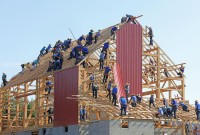- Home
- Business Processes
- Industry Knowledge
- Aerospace Industry
- Automotive Industry
- Banking Domain
- BFSI Industry
- Consumer/ FMCG Industry
- Chemicals Industry
- Engineering & Construction
- Energy Industry
- Education Domain
- Finance Domain
- Hospitality Domain
- Healthcare Industry
- Insurance Domain
- Retail Industry
- Travel and Tourism Domain
- Telecom Industry
- Leadership Skills
- eLearning
- Home
- Leadership
- Team Leadership
- Factors of Leadership
Factors of Leadership
There are four major factors in leadership called Leader, Follower, Communication, and Situation. The success of the leader is dependent on how the leader is effectively able to communicate and motivate followers to perform desired tasks using the appropriate leadership style best suited for the given situation. Interdependencies and dynamics of these four factors of leadership must be considered by a leader to be effective.
Four sets of forces are believed to contribute to effective leadership. They are leaders, subordinates, general situations, and organizational systems. Firstly, the nature of the leader particularly attitudes, values, knowledge, skill, experience, maturity, emotional flexibility, etc., acquired since birth, influences his feelings, assumptions, perceptions, and behavior.
There are four factors in leadership. As we know, leadership is a process that involves a relationship, and therefore it cannot exist in isolation. The leadership has no subsistence if there is no follower(s) and a situation. Thus Leadership has three inevitable components -a leader, followers, and a situation and they all are linked by the medium of communication. The relationship between leadership, followership, and the situational and organizational context within which the interactions (communication) between leaders and followers occur constitute the leadership process.
Various organizational and other situational forces will affect these four factors like the leader’s relationship with his team, peers and seniors, the skill and capabilities of his followers, the interplay of informal leaders within his organization, and how his organizational structure is organized.
1. First Factor - The Leader Himself
The first factor in leadership is the leader itself. Leadership is defined as a process, whereby individual influences a group of individuals to achieve a common goal. Hence leadership is a transactional event that takes place between leader and the led. It affects both the leader and the led in the process of interaction. It is not a one-way event, but it is an interactive event.
The fundamental starting point for a leader is to have a good understanding of human nature, such as needs, emotions, and motivation. The leader must have high levels of self-awareness; build an honest understanding of who he is, what he knows, and what he can do.
Each leader needs to establish interpersonal relations with members, inspire them, guide them, and help them to march towards the goals.
Leaders are expected to influence people to form a group by bringing members together, induce a purpose and inspire followers to aspire for it, put life in the purpose; make it operational by defining the steps on how to achieve the common goal, and provide direction during the course of achievement.
Different people require different styles of leadership. For example, a new hire requires more supervision than an experienced employee. A person who is demotivated requires a different approach than one with a high degree of motivation. The leader must know his employees and their attributes.
2. Second Factor - Existence of Followers
Leadership implies the existence of followers. Generally, it is the followers, who determine if the leader is successful by providing their support and accomplishing the needed tasks. Leadership is not about doing things themselves but motivating the followers to work towards business objectives. Here is always an unequal distribution of authority among leaders and group members and commonality of interest between the leader and his followers.
Leadership always takes place in groups. Leadership involves influencing the group to achieve common goals. Understanding of the leadership is always in the context of the level of the followers and there with the leaders.
Understanding of the leadership is always in the context of the level of the followers and there with the leaders. Both leaders and followers have involved together with the leadership process. The leaders are in the task of taking initiatives and by which they link themselves with the stakeholders.
If followers do not trust or lack confidence in their leader, then they will be uninspired. To be successful the leader, the leader must know his people, must convince his followers, that he is worthy of being followed.
A leader's assumptions about subordinates like that of Theory X and Theory Y will have quite different implications on their style and effectiveness. Secondly, the subordinates with their knowledge and skill, their needs for independence, their acceptance of the management's objectives, their tolerance for ambiguity, and their expectations that they should share in decision making also affect the style and effectiveness of their leader. Understanding these basic individual differences in the followers affects the leadership style and leadership itself. The kind of personality exhibited by the followers in an organization also helps in deciding the style to be adopted. For instance, if employees in an organization prefer a high need for independence, show readiness to assume responsibility, display interest in problem-solving and decision making, then leaders permit greater freedom.
Thus the leadership of a group or organization comprises the direction, impetus, and energy that arises from the circulation of initiatives. An initiative is passed on to the followers who react, respond, and add to circulation, generating their own initiatives.
The general working conditions which are conducive to effective leadership from the angle of subordinates are grouped as leadership conditions that provide for the security of subordinates and leadership conditions that provide for independence for subordinates.
Conditions relating to security include an atmosphere of approval (i.e., the freedom to make a mistake and allowing for an honest mistake), knowledge of subordinates (that is letting subordinates know in clear terms about procedures, rules, regulations, duties, responsibilities overall policy of the organization, performance evaluation procedure, personal peculiarities of his/her superior) and finally the consistency of discipline indicating clearly both desirable and undesirable behavior the conditions about independence are concerned with opportunity for participation, responsibility and the right to appeal.
Throughout the process, there are multiplicities of leaders engaging in actions that comprise this continual circulation.
3. The Third Factor - Two-way Communication
The leader leads through two-way communication. He has to set the example and communicate to them that he would not ask them to perform anything that he would not be willing to do. Leaders establish vision and mission and set the direction for the organization, communicate the vision to the people in the organization and synchronize them with the organizational vision and mission, thereby inspire the people to translate the goals, vision, and mission into reality.
The leader listens closely to people at work and organizes and clearly presents information both orally and in writing. Communicate with all personnel with a sense of mutual understanding and mutual loyalty to the aims of business objectives, Generate enthusiasm for projects, and inspire working towards their completion. A leader is always contributing to the group by advancing useful suggestions, tracking progress, providing direction and guidance where necessary.
Leaders demonstrating communication skills are both good speakers and listeners. The leader listens closely to people at work and organizes and clearly presents information both orally and in writing. Through their words, they can help keep the workforce motivated and committed. They also listen to their followers and ask questions when they want to make sure they have a good understanding of what is being expressed.
Through their leadership skills, they maintain a high level of performance in their organizations, and they are able to help keep their workforce motivated even when faced with a seemingly impossible situation.
What and how the leader communicates either positively build or negatively harm the relationship between the leader and his employees. Good leaders communicate with all personnel with a sense of mutual understanding and mutual loyalty to generate enthusiasm for projects and inspire working towards their completion.
4. The Forth Factor - The Situation
To a large extent, the functions and activities of leaders are contingent upon the situation in which leaders work and they are found to vary with a number of factors. All situations are different. A methodology or approach that is successful in one situation will not always work in another. The leader must use his judgment to decide the best course of action and the leadership style needed for each situation.
A successful leader is sensitive to the influences in various situations and they are in a position to determine the right style of leadership to be followed in handling various situations. We all know that each situation elicits a different behavior in people, thus for each opportunity that is presented the leader must use his/ her judgment to decide the best course of action and the leadership style needed for each situation.
For example, the leader may need to confront an employee for inappropriate behavior, but if the confrontation is too late or too early, too harsh or too weak, then the results may prove ineffective. This is especially true in the case of the team members, who can react very differently to various situations.
The situation normally has a greater effect on a leader’s action than his or her traits. This is because while traits may have impressive stability over a period of time, they have little consistency across situations. This is why a number of leadership scholars think the Process Theory of Leadership is more accurate than the Trait Theory of Leadership. The situation could be a result of the nature of the task to be performed or due to the structure of the organization and may require different leadership styles to be adopted.
The nature of the task performed in an organization plays a greater role in determining the leadership style. If the nature of the task to be performed in an organization is quite critical and the time is too short in taking decisions, autocratic styles may be used by leaders, whereas in handling the simple tasks with no pressures of time, the leader might adopt a participative style.
The situational forces which have a bearing on the style of leadership include the style of the leader's supervisors, complexity and demands of the job, and pressure of time (e. g., emergency or crises vs. normal). Lastly, the forces in the organization system which determine the style and effectiveness of the leadership include division of work, organization structure, and the production technology being adopted by the organization.
The structure of the organization may determine the kind of leadership to be adopted. For instance, some organizations may put a heavy emphasis on the leader’s abilities to work effectively with people. At other times, the social, economic, and political pressures that an organization faces prompt certain styles of leadership to be followed.
Related Links
You May Also Like
-
Modern Approaches to Management
The modern approaches to management look at organizational management in the current context. They take a holistic approach and look at organizations as a collection of interrelated parts influenced by both internal dynamics and also the larger external environment. These modern management theories have played a significant role in the evolution of management studies.
-
Theory Z also called the "Japanese Management" style is a leadership theory of human motivation focused on organizational behavior, communication, and development. It assumes that employees want to enter into long term partnerships with their employers and peers. Offering stable jobs with an associated focus on the well-being of employees results in increased employee loyalty to the company.
-
In today's business world, proficiency in management skills is essential for career growth and success. Managerial skills can be defined as attributes or abilities that are essential for every leader and manager to succeed and fulfill specific tasks expected from them by the organization.
-
Maslow's hierarchy of needs is a motivational theory that explains that people are motivated by five basic categories of human needs. These needs are physiological, safety, love and belonging, esteem, and self-actualization. There is a little scientific basis for this concept of a hierarchy of needs.
-
Management theories are the recommended management strategies that enable us to better understand and approach management. Many management frameworks and guidelines were developed during the last four decades.
-
There are four major factors in leadership called Leader, Follower, Communication, and Situation. The success of the leader is dependent on how the leader is effectively able to communicate and motivate followers to perform desired tasks using the appropriate leadership style best suited for the given situation. Interdependencies and dynamics of these four factors of leadership must be considered by a leader to be effective.
-
Frederick Winslow Taylor started the “Scientific Management Movement”, and attempted to study the work process scientifically. Scientific management, also called Taylorism, was a theory of management that analyzed and synthesized workflows. It is a system for increasing the efficiency of manpower to its maximum potential and streamlining production to improve efficiency. This article explores this theory in more detail.
-
Team Foundation in Forming Stage
This is the first stage of team development. This is the stage when the foundation of the team is laid. During the Forming stage, team members have a high dependence on their leader for guidance. Learn the practical strategies you can use during this stage to help your team develop into a highly effective performing team.
-
The development of teams is an ongoing process because the composition of the team may keep on changing. The new members may join and the old members may leave the team. The team members pass through several stages for the development of the team and there has been a lot of research to identify these stages. In this article, we discuss the common theories of team development.
-
Certain generally accepted truths or principles of communication are important to consider when communicating with others. These principles hold true for all people in every culture. By understanding these principles, you will experience greater communication effectiveness. An effective communication system is one that achieved its objectives. Communication is effective where there are no barriers to communication.
Explore Our Free Training Articles or
Sign Up to Start With Our eLearning Courses

About Us
Learning
© 2023 TechnoFunc, All Rights Reserved










